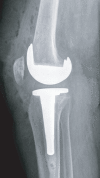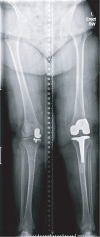Haemosiderotic Synovitis Secondary to Anticoagulant Use: An Unusual Mechanism of Failure of a Unicompartmental Knee Replacement
- PMID: 31815028
- PMCID: PMC6878778
- DOI: 10.1155/2019/3959278
Haemosiderotic Synovitis Secondary to Anticoagulant Use: An Unusual Mechanism of Failure of a Unicompartmental Knee Replacement
Abstract
Haemosiderotic synovitis is a rare condition caused by recurrent or chronic haemarthroses. This may lead to intra-articular destruction, a painful joint, and, if untreated, ankylosis of the joint. We highlight a case of an elderly lady who presented to an orthopaedic clinic with left knee pain, following recurrent left knee atraumatic haemarthroses secondary to oral anticoagulant use. At her presentation, she had a left medial unicompartmental knee prosthesis in situ. Weight bearing radiographs of the left knee showed marked loss of lateral joint space with valgus alignment. These radiographic findings were not present on the radiographs taken at her first presentation with haemarthrosis nine months previously. A left revision total knee arthroplasty was performed, and a diagnosis of haemosiderotic synovitis was made following histological analysis of intraoperative tissue samples. This case highlights an unusual mechanism of failure of a unicompartmental knee replacement. Though haemosiderotic synovitis is an exceedingly rare condition, it must be considered following recurrent haemarthrosis as, due to its destructive nature, prompt recognition and treatment is paramount.
Copyright © 2019 Jonathan Bartlett et al.
Conflict of interest statement
The authors declare that they have no conflicts of interest.
Figures







References
Publication types
LinkOut - more resources
Full Text Sources

